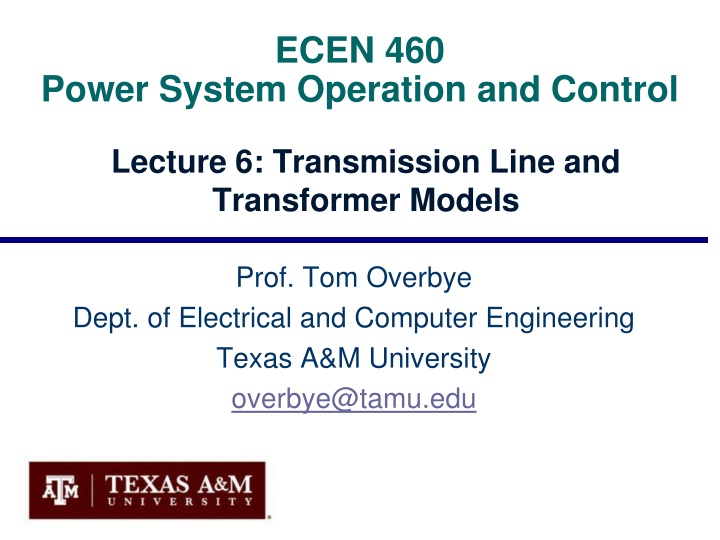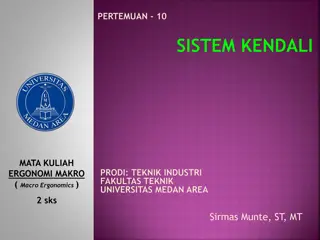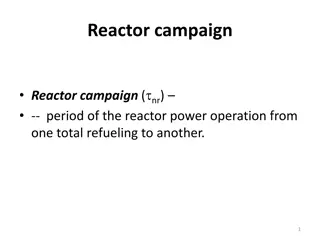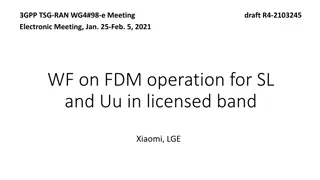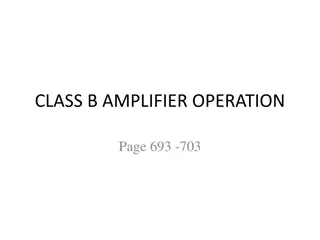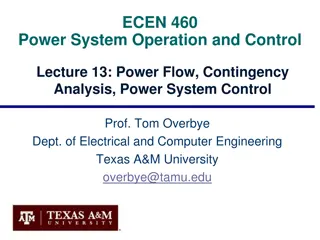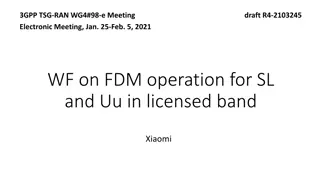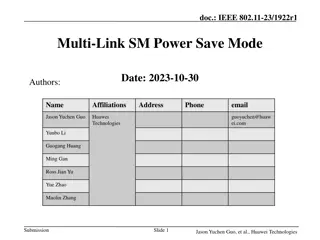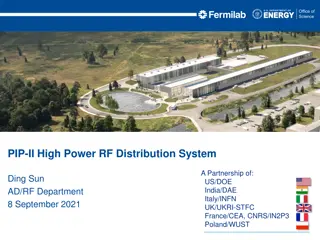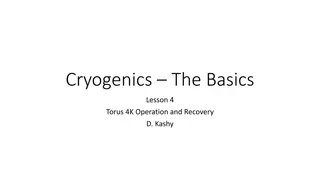Power System Operation and Control
Learn about transmission line and transformer models in power systems, including topics like transposition, conductor bundling, inductance calculations, and more. Explore the concepts behind geometric mean distance, balancing systems, and bundled conductor configurations to understand the complexities of high voltage transmission lines.
Download Presentation

Please find below an Image/Link to download the presentation.
The content on the website is provided AS IS for your information and personal use only. It may not be sold, licensed, or shared on other websites without obtaining consent from the author.If you encounter any issues during the download, it is possible that the publisher has removed the file from their server.
You are allowed to download the files provided on this website for personal or commercial use, subject to the condition that they are used lawfully. All files are the property of their respective owners.
The content on the website is provided AS IS for your information and personal use only. It may not be sold, licensed, or shared on other websites without obtaining consent from the author.
E N D
Presentation Transcript
ECEN 460 Power System Operation and Control Lecture 6: Transmission Line and Transformer Models Prof. Tom Overbye Dept. of Electrical and Computer Engineering Texas A&M University overbye@tamu.edu
Announcements Please read book Chapter 3 (though only some parts are covered in ECEN 460) HW 2 is 2.32, 4.1, 4.10, 4.20, due on Sept 21 For 4.20 use the book s Table A.4 values to determine the Geometric Mean Radius of the wires (i.e., the ninth column). WEB 115 now has network access for you to save files; you can access them in any of the ECEN labs Labs 2 and 3 will be in WEB 115 PowerWorld just released version 20, which lets you run the demo cases I showed in class https://www.powerworld.com/gloveroverbyesarma 1
Transposition To keep system balanced, over the length of a transmission line the conductors are rotated so each phase occupies each position on tower for an equal distance. This is known as transposition. Aerial or side view of conductor positions over the length of the transmission line. 3
Inductance of Transposed Line Define the geometric mean distance (GMD) 13 ( ) D 12 13 23 d d d m = Then for a balanced 3 system ( - - ) I I I a b c 1 r 1 D r 0 0 m = = ln ln ln I I I a a a a 2 ' 2 ' D m Hence D r D r 7 0 m m = = 2 10 ln ln H/m L a 2 ' ' 4
Conductor Bundling To increase the capacity of high voltage transmission lines it is very common to use a number of conductors per phase. This is known as conductor bundling. Typical values are two conductors for 345 kV lines, three for 500 kV and four for 765 kV. 5
Bundled Conductor Pictures The AEP Wyoming-Jackson Ferry 765 kV line uses 6-bundle conductors. Conductors in a bundle are at the same voltage! Photo Source: BPA and American Electric Power 6
Inductance of Lines with Bundled Conductors The per phase inductance is The detailed derivation is given in ECEN 459 D R 0 = L ln a 2 b where R geometric mean radius (GMR) of bundle b 1 = b ( ' r d ) in general d 12 1 b When calculating the per phase resistance of bundled lines, the total resistance is R per conductor divided by b, where b is the number of conductors in the bundle 7
Bundle Inductance Example Consider the previous example of the three phases symmetrically spaced 5 meters apart using wire with a radius of r = 1.24 cm. Except now assume each phase has 4 conductors in a square bundle, spaced 0.25 meters apart. What is the new inductance per meter? ( b R 9.67 10 0.12 m (ten times bigger!) 2 3 = = 9.67 10 m 1.24 10 m ' r r 1 ) 0.25 M 3 4 = 0.25 0.25 2 0.25 = 0.25 M 0.25 M 5 7 0 = = L ln 7.46 10 H/m a 2 0.12 8
Inductance Example Calculate the per phase inductance and reactance of a balanced 3 , 60 Hz, line with horizontal phase spacing of 10m using three conductor bundling with a spacing between conductors in the bundle of 0.3m. Assume the line is uniformly transposed and the conductors have a 1cm radius. Answer: Dm = 12.6 m, Rb= 0.0889 m Inductance = 9.9 x 10-7 H/m, Reactance = 0.6 /Mile 9
Line Capacitance High voltage transmission lines and cables can have significant capacitance For the case of uniformly transposed lines we use the same D and a similar GMR as with inducance, 2 C D R m = ln m c b 13 = where D ab ac bc d d d m 1 c b = n R ( ) (note r NOT r') rd d 12 1 n -12 = = in air 8.854 10 F/m o 10
Line Capacitance Example Calculate the per phase capacitance and susceptance of a balanced 3 , 60 Hz, transmission line with horizontal phase spacing of 10m using three conductor bundling with a spacing between conductors in the bundle of 0.3m. Assume the line is uniformly transposed and the conductors have a a 1cm radius. 11
Line Capacitance Example, contd 13 c b = (0.01 0.3 0.3) = 0.0963 m R 13 = (10 10 20) = D 12.6 m m 12 2 8.854 10 12.6 ln0.0963 11 = = 1.141 10 F/m C 1 C 1 = = X c 11 2 60 1.141 10 F/m 8 = 2.33 10 -m (not /m) 12
Additional Transmission Topics Multi-circuit lines: Multiple lines often share a common transmission right-of-way. This DOES cause mutual inductance and capacitance, but is often ignored in system analysis. Cables: There are about 3000 miles of underground ac cables in U.S. Cables are primarily used in urban areas. In a cable the conductors are tightly spaced, (< 1ft) with oil impregnated paper commonly used to provide insulation inductance is lower capacitance is higher, greatly limiting cable length 13
Additional Transmission Topics Ground wires: Transmission lines are usually protected from lightning strikes with a ground wire. This topmost wire (or wires) helps to attenuate the transient voltages/currents that arise during a lighting strike. The ground wire is typically grounded at each pole. Corona discharge: Due to high electric fields around lines, the air molecules become ionized. This causes a crackling sound and may cause the line to glow! 14
Additional Transmission Topics Shunt conductance: Usually ignored. A small current may flow through contaminants on insulators. DC Transmission: Because of the large fixed cost necessary to convert ac to dc and then back to ac, dc transmission is only practical for several specialized applications long distance overhead power transfer (> 400 miles) long cable power transfer such as underwater providing an asynchronous means of joining different power systems (such as ERCOT to Eastern or Western grids) 15
Transmission Line Models Previous lectures have covered how to calculate the distributed inductance, capacitance and resistance of transmission lines. In this section we will use these distributed parameters to develop the transmission line models used in power system analysis. 16
Transmission Line Equivalent Circuit Our current model of a transmission line is shown below Units on z and y are per unit length! For operation at frequency , let z = r + j L and y = g +j C (with g usually equal 0) 17
Propagation Constant, Characteristic and Surge Impedance Define the propagation constant as = = + yz j where = = the attenuation constant the phase constant z y = = Define Z characteristic impedance c 18
Lossless Transmission Lines For a lossless line the characteristic impedance, Z , is known as the surge impedance. c jwl jwc l c = = (a real value) Z c If a lossless line is terminated at bus R in impedance V I I Z V = ... = R Z c R Then so we get R c R 19
Lossless Transmission Lines = = + + ( ) ( ) ( ) ( ) I x cosh cosh sinh sinh This equation is derived in Chapter 5, but this derivation is not part of ECEN 460 V x I x V x V I x V x x x R R I R R = Z c 2 V(x) Z Define as the surge impedance load (SIL). c Since the line is lossless this implies ( ) ( ) R I x I = = V x V R If P > SIL then line consumes vars; otherwise line generates vars. 20
Example 5.4 2199 MW -0 Mvar 765.0 kV 765.0 kV Angle Difference: -21.4 Deg slack 2199 0 MW Mvar The 2199 MW represents the surge impedance loading; for values above this the line consumes reactive power, for values below this it generates reactive power. 22
Equivalent Circuit Model The common representation is the equivalent circuit Next we ll present simplified ways to determine the parameters Z' and Y'. 23
Simplified Parameters These values can be derived to be zl z yl z = = ' sinh sinh Z Z l l C sinh l = = with Z zl (recalling ) Z zy l ' 1tanh c Z Y l yl y zl y l = = tanh 2 2 l 2 tanh Y 2 = with Y yl l 2 2 25
Simplified Parameters, cont. For most lines make the following approximations: sinh l = ' (assumes 1) Z Z l ' tanh( / 2) Y Y l = (assumes 1) 2 2 / 2 l sinh l l tanh( l / 2) l / 2 Length 50 miles 100 miles 200 miles 0.998 0.02 0.993 0.09 0.972 0.35 1.001 1.004 1.014 0.01 0.04 0.18 26
Three Line Models Long Line Model (longer than 250 miles) l tanh sinh ' l Y Y 2 = = use ' , Z Z l 2 2 l 2 Medium Line Model (less than 250 miles) Y use and 2 use (i.e., assume Z low voltage lines) Z Short Line Model (not used much but useful for insight) Y is zero; it small for short or 27
Power Transfer in Short Lines Often we'd like to know the maximum power that could be transferred through a short transmission line I1 I1 S21 Transmission Line with Impedance Z = + + V1 S12 V2 - - * V V * 1 2 = S 1 1 V I V 12 1 Z V = = = with , V V V Z Z 1 1 2 2 2 Z 1 2 V V V Z 1 Z 1 2 = + S 12 12 Z Z 28
Power Transfer in Lossless Lines If we assume a line is lossless with impedance jX and are just interested in the real power transfer then: 2 V V V Z 1 Z 1 2 + = + 90 90 P jQ 12 12 12 + = Since -cos(90 V V P = ) sin , we get 12 12 1 2 sin 12 12 X Hence the ma ximum power transfer is V V X Max 1 2 = P 12 29
Limits Affecting Max. Power Transfer Thermal limits limit is due to heating of conductor and hence depends heavily on ambient conditions. For many lines, sagging is the limiting constraint. Newer conductors limit can limit sag. For example 3M has lines with a core consisting of ceramic Nextel fibers. These lines can operate at 200 degrees C. Higher currents and operating temperatures mean higher losses! Trees grow, and many will eventually hit lines if they are planted under the line. 30
Other Limits Affecting Power Transfer Angle limits while the maximum power transfer occurs when line angle difference is 90 degrees, actual limit is substantially less due to multiple lines in the system Voltage stability limits as power transfers increases, reactive losses increase as I2X. As reactive power increases the voltage falls, resulting in a potentially cascading voltage collapse. 31
Example 5.8 765.0 kV 0.0 Deg 816.7 kV -11.4 Deg 847.3 kV -19.5 Deg 857.8 kV -27.3 Deg A A A MVA MVA MVA A A A MVA MVA MVA A A A slack MVA MVA MVA 9000 0 MW Mvar 9000 MW -2912 Mvar A A A MVA MVA MVA A A MVA MVA 32
Transmission Line Series Compensation One way to increase the transmission capacity of a transmission line that is limited by its reactance is to add series compensation Capacitors are placed in series with the transmission line (covered in Example 5.10) Image shows BPA series capacitors in a 500 kV line Image: https://www.bpa.gov/news/newsroom/Pages/Chief-engineers-reunite-reminisce-for-BPAs-75th.aspx
Transmission Line Series Compensation Amount of series compensation is expressed as a percentage of the total line reactance (e.g., 50%) The series capacitance is usually setup so that it can be bypassed sometimes There can be excessive reactive power generation on the system during light loads, like at night There can be a concern with sub-synchronous interactions (SSI) 1 LC X X = = C f f 0 n L
Example 5.10 765.0 kV 765.0 kV slack YES YES 2200 0 MW Mvar 2200.0 MW -0.2 Mvar Line Angle Difference: -21.4 Deg
